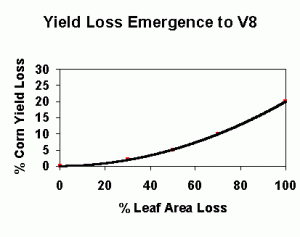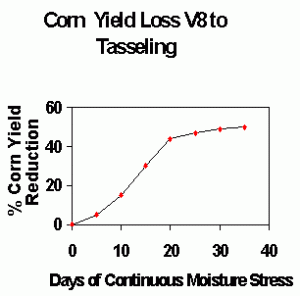The Impact of Early Drought on Corn Yield
go.ncsu.edu/readext?355859
en Español / em Português
El inglés es el idioma de control de esta página. En la medida en que haya algún conflicto entre la traducción al inglés y la traducción, el inglés prevalece.
Al hacer clic en el enlace de traducción se activa un servicio de traducción gratuito para convertir la página al español. Al igual que con cualquier traducción por Internet, la conversión no es sensible al contexto y puede que no traduzca el texto en su significado original. NC State Extension no garantiza la exactitud del texto traducido. Por favor, tenga en cuenta que algunas aplicaciones y/o servicios pueden no funcionar como se espera cuando se traducen.
Português
Inglês é o idioma de controle desta página. Na medida que haja algum conflito entre o texto original em Inglês e a tradução, o Inglês prevalece.
Ao clicar no link de tradução, um serviço gratuito de tradução será ativado para converter a página para o Português. Como em qualquer tradução pela internet, a conversão não é sensivel ao contexto e pode não ocorrer a tradução para o significado orginal. O serviço de Extensão da Carolina do Norte (NC State Extension) não garante a exatidão do texto traduzido. Por favor, observe que algumas funções ou serviços podem não funcionar como esperado após a tradução.
English
English is the controlling language of this page. To the extent there is any conflict between the English text and the translation, English controls.
Clicking on the translation link activates a free translation service to convert the page to Spanish. As with any Internet translation, the conversion is not context-sensitive and may not translate the text to its original meaning. NC State Extension does not guarantee the accuracy of the translated text. Please note that some applications and/or services may not function as expected when translated.
Collapse ▲Corn is very susceptible to drought damage due to the plant’s requirement for water for cell elongation and it’s inability to delay vegetative growth. Therefore, there is always the danger of yield loss regardless of the timing of dry weather. In fact, the golden rule of corn production is that highest yields will be obtained only where environmental conditions are favorable at all stages of growth. The amount of yield loss that occurs during dry weather depends on what growth stage the corn is in and how severe the dry conditions become. The following are some general guidelines for corn yield loss by growth stage.
Emergence to V8
(eighth leaf full emerged or about 4 weeks after planting)
Growth during this period determines the size that the plant achieves and the size of the individual leaves. Dry weather during this period will reduce plant and leaf size. Impact on yield will be based on the reduction in leaf area available for photosynthesis. Minor reductions in leaf size will have little impact on yield while major reductions (all leaves removed from the plant) could reduce potential yields as much as 20 percent. Extended dry weather that results in leaf burning and loss will have the greatest impact on yield. The following chart shows the relationship between leaf area and yield loss during this growth period. Remember that even though there is little or no leaf burn, leaf size can be effected by drought and result in reduction in leaf area.

V8 to V16
(All leaves emerged, start of tasseling; from 4 weeks to 66 days after plant emergence)
Plant growth in this period determines ear size and the number of kernels set. From V8 to V14, ear size is set. Drought during this period will reduce ear size and potential yield. Yield losses will be related to the length and severity of drought. Potential yield losses can range from 10 percent to 30 percent. From V14 to tasseling, the number of kernels that can be fertilized are determined. Drought during this period drought stress can reduce corn yields 10 to 50 percent. Throughout the V8 to V16 period the key question is how long the drought stress is present. The following chart has been compiled from the best information available showing the relationship between the length of drought during the V8 to V16 period and the loss of potential corn yield.

Silking
This is the most sensitive stage for drought stress. Drought during silking coupled with high temperatures can result in 100 percent loss. This occurs most frequently in the midwest where high daytime temperatures can kill pollen before it can reach the silks. In the southeast, high humidity often results in heavy dew which can help pollinate the corn silk. However, severe yield reductions can occur due to incomplete pollination and the loss of kernel number. There are no good measures of yield loss. Scouting of the corn crop can determine the number of kernels set following pollination and can help determine yield potential. To determine if pollination has occurred, remove the shucks from the ear and take your hand and run it over the surface of the ear. If the silks brush off easily, then the kernel has been pollinated. If the silks stay attached then pollination has not occurred. Another good measure of pollination is to examine the length of the silks. The silk will continue to grow until pollination occurs or until it becomes damaged. The longer the silks the less efficient the pollination process was.
Silking to Maturity
Drought during this period effects kernel weight. Severe drought can reduce corn yields during this period by 20 to 30 percent. Again, the key factor is how long the drought occurs and how late in this period it occurs. Drought immediately following silking has the largest impact, and can reduce yield substantially. Drought latter in this period is less damaging but can hasten maturity.
While each stage is important, drought during some stages can be especially devastating. The key stage is silking followed by the V8 to V16 period and then the grain fill period from silking to maturity. Drought that continues across several growth stages can result in complete crop failure


